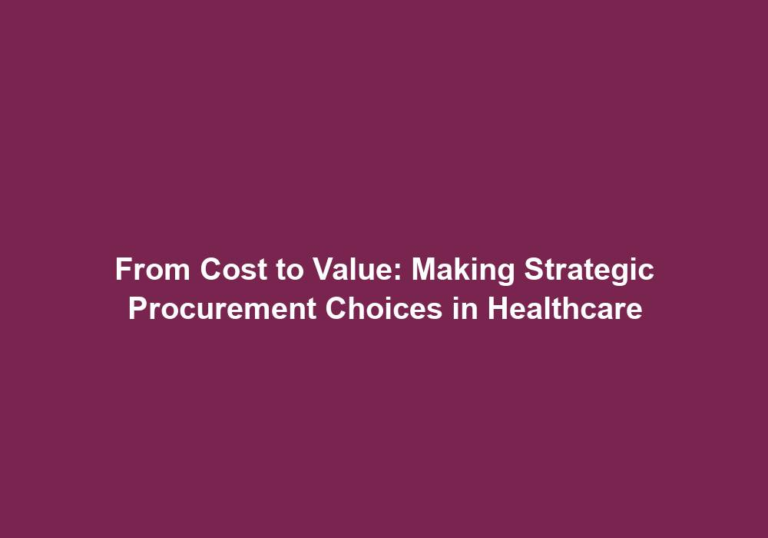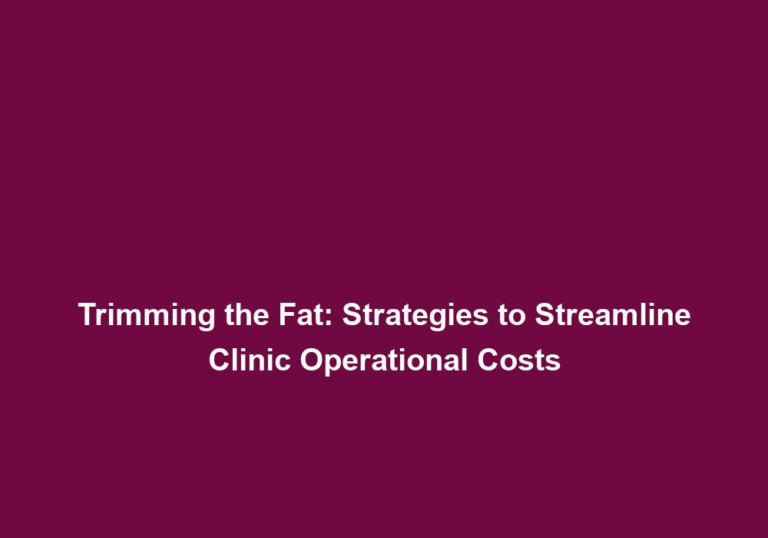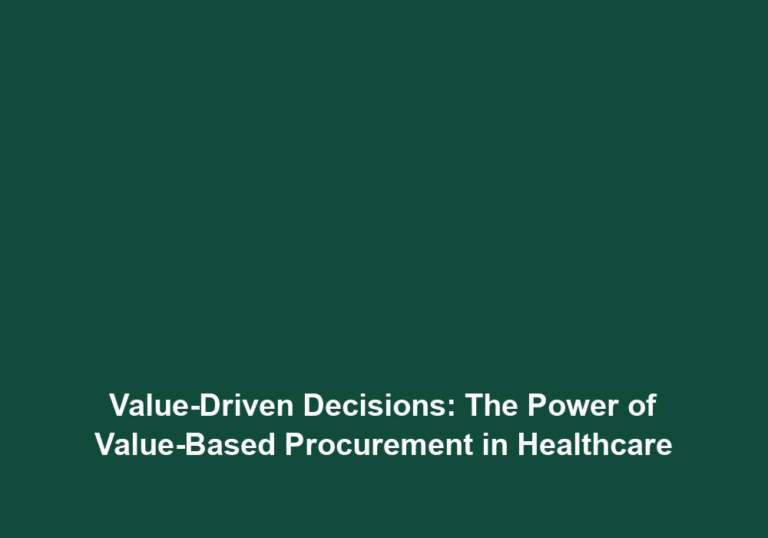Sourcing for Savings: Embracing Value-Based Procurement in Clinics
In today’s healthcare industry, clinics face the ongoing challenge of providing quality care while operating within tight budgets. As medical costs continue to rise, it becomes crucial for clinics to find innovative approaches to save money without compromising patient care. One effective strategy that clinics can adopt is value-based procurement, which focuses on obtaining the best value for every dollar spent on medical supplies and equipment. In this article, we will explore the concept of value-based procurement and its significance in clinics, as well as provide practical tips for implementing this approach.
Understanding Value-Based Procurement
Value-based procurement is a strategic approach to purchasing that prioritizes the overall value derived from a product or service, rather than simply looking at the initial cost. It involves considering factors such as quality, long-term benefits, and the impact on patient outcomes. By embracing value-based procurement, clinics can achieve cost savings while ensuring that they are investing in high-quality products and services that align with their goals and objectives.
Value-based procurement goes beyond just focusing on the price tag of a product or service. It takes into account the long-term costs and benefits associated with different options. Clinics can evaluate the quality and reliability of the products, the potential impact on patient outcomes, and the supplier’s reputation. By considering these factors, clinics can make informed decisions that optimize their budget allocation and maximize the value they receive from their purchases.
Furthermore, value-based procurement encourages clinics to think about the long-term benefits and impact on patient care. By investing in high-quality products and services, clinics can improve diagnosis, treatment, and overall patient satisfaction. For example, choosing reliable medical equipment can lead to accurate diagnoses and effective treatments, ultimately resulting in better patient outcomes.
To implement value-based procurement successfully, clinics must define their evaluation criteria. These criteria should reflect the clinic’s priorities, such as quality, cost, patient outcomes, and supplier reliability. By establishing clear evaluation criteria, clinics can guide their procurement decision-making process and ensure that the chosen products and services meet their specific requirements.
Importance of Value-Based Procurement in Clinics
-
Cost-Effectiveness: Value-based procurement helps clinics identify cost-effective solutions that deliver the best results and value for their investment. By evaluating the long-term costs and benefits of different options, clinics can make informed decisions that optimize their budget allocation. This approach allows clinics to achieve tangible cost savings without compromising patient care.
-
Improved Patient Outcomes: By focusing on the value derived from procurement decisions, clinics can ensure that they are investing in products and services that positively impact patient outcomes. This approach encourages the selection of high-quality medical supplies and equipment, leading to better diagnosis, treatment, and overall patient satisfaction. Clinics can prioritize products that have been proven to improve patient outcomes and enhance the overall quality of care provided.
-
Supplier Relationships: Value-based procurement fosters collaborative relationships with suppliers. By prioritizing long-term value rather than short-term gains, clinics can build partnerships with suppliers who share their commitment to quality and cost-effectiveness. Such relationships can lead to favorable pricing, improved service levels, and access to innovative solutions. Clinics can establish open communication channels with suppliers and engage them in discussions about value-based procurement. By sharing their clinic’s goals and requirements, clinics can encourage suppliers to offer innovative solutions and competitive pricing.
-
Risk Mitigation: Value-based procurement allows clinics to assess potential risks associated with their purchasing decisions. By considering factors such as product reliability, warranty, and supplier reputation, clinics can minimize the risk of equipment failure or premature obsolescence. This proactive approach helps clinics avoid costly disruptions in their operations and ensures the continuity of patient care. Clinics can leverage technology and procurement tools to streamline the procurement process and gather data-driven insights into supplier performance, pricing trends, and product quality.
Practical Tips for Implementing Value-Based Procurement
-
Identify Key Stakeholders: To successfully implement value-based procurement, clinics should involve all relevant stakeholders, including clinicians, administrators, and procurement professionals. This collaborative approach ensures that the procurement strategy aligns with the clinic’s overall goals and objectives. By involving key stakeholders, clinics can gather diverse perspectives and insights that can contribute to the success of the value-based procurement initiative.
-
Define Evaluation Criteria: Develop a set of evaluation criteria that reflects the clinic’s priorities, such as quality, cost, patient outcomes, and supplier reliability. This will help guide the procurement decision-making process and ensure that the chosen products and services meet the clinic’s specific requirements. Clinics can establish clear evaluation criteria that take into account the unique needs and goals of their organization.
-
Leverage Technology: Utilize procurement software and tools to streamline the procurement process and facilitate data-driven decision-making. These tools can provide insights into supplier performance, pricing trends, and product quality, enabling clinics to make informed choices that maximize value. By leveraging technology, clinics can automate manual procurement processes, reduce errors, and improve efficiency.
-
Engage Suppliers: Establish open communication channels with suppliers and engage them in discussions about value-based procurement. By sharing your clinic’s goals and requirements, you can encourage suppliers to offer innovative solutions and competitive pricing. Regularly evaluate supplier performance to ensure they continue to meet your expectations. Engaging suppliers in the value-based procurement process can lead to collaborative partnerships that benefit both parties.
-
Continuous Improvement: Value-based procurement is an ongoing process that requires continuous evaluation and improvement. Regularly review procurement practices, track cost savings, and gather feedback from stakeholders to identify areas for enhancement. This iterative approach will help clinics optimize their procurement strategy over time and adapt to changing needs and market conditions.
Conclusion
By embracing value-based procurement, clinics can achieve tangible cost savings while ensuring the delivery of high-quality care to their patients. This approach enables clinics to make informed purchasing decisions that prioritize long-term value, improved patient outcomes, and collaborative supplier relationships. Implementing value-based procurement requires careful planning, stakeholder involvement, and the use of technology to streamline the procurement process. By continuously evaluating and improving their procurement practices, clinics can optimize their budget allocation while providing the best possible care to their patients.






